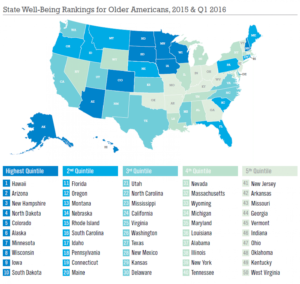Every Monday on this blog we recap the most engaging content from the previous week.
This week, we take an in-depth look at the effect that the Americans with Disabilities Act will have on commercial websites in the coming years. Also, the Washington Post reveals the reasons why older Americans are happier in some states than others.
Most Clicked: The Importance of Website Accessibility
Last week, Business 2 Community published What the Americans with Disabilities Act (ADA) means for Your Website. The article analyzed the growing demand for accessible websites and the the penalties that companies face if their websites are found to discriminate against the one-out-of-five Americans living with a disability.
According to the Department of Labor, “the Americans with Disabilities Act prohibits discrimination against people with disabilities in employment, transportation, public accommodation, communications and governmental activities.” Several well-known brands, including Target, JCPenney and Bed Bath and Beyond, have had complaints filed against them due to perceived violations of the ADA in recent years.
According to Texas A&M University Corpus Christi, disability rates increase with age. Currently, 44% of adults ages 65-74 have at least one disability. This percentage increases to 63% for adults 75-84 and 84% for adults 85 and over. These percentages are important for marketers in the senior industry to take into consideration, especially in regards to how they affect website accessibility requirements.
While currently there are no official rules regarding the minimum accessibility requirements for commercial websites, for marketers — especially those in the senior living industry — now is the time to ensure that websites are made accessible. Why? Because the older the adult, the more prevalent the rate of disabilities.
Here are some improvements that you can make that will go a long way to ensuring that your website meets accessibility standards:
- Larger Text: As we get older, our vision diminishes. Make it easier for everyone to find the information that they are looking for on your website. Larger text will ensure that those with impaired vision aren’t frustrated by having to squint to find the information they need on your site.
- Color and Contrast: Color can make the user experience on your website a pleasant one or a disappointing one. If you are targeting the older demographics, use calmer colors, such as blue, green or purple, and make sure that the contrast between the text color and background is enough for users to read your content without any added strain.
- Accessibility Guides: Some accessibility guides give users the option to view websites in a way that has been tailored to overcome anything that may hinder them from getting the intended web experience such as hearing or vision impairment. One example is the BBC’s “My Web My Way.” For companies that don’t have the budget to create such an extensive accessibility guide, you can still provide those with disabilities the information necessary for navigating your site.
The earlier your company starts making these accessibility changes to your website, the better. Official guidelines for web accessibility are currently in their beginning stage, and once they are finalized, companies will have two years to ensure their websites meet these guidelines.
Why wait to make your website accessible when you can be proactive and start making these changes today?
Not only will it save you from web development headaches in the future, it also will give you an advantage over competitors whose websites are lagging behind in the accessibility department.
Click here for Creating Results’ Top 15 Design Tips for the Mature Consumer. Following these guidelines will help you ensure that your website meets accessibility standards for seniors.
Most Shared: It’s All About Location
According to an article written by Tara Bahrampour and published by The Washington Post, Hawaii is the state where older Americans are the happiest.
This finding is the result of a phone survey conducted as part of the annual Gallup-Healthways State of American Well-Being series. Over 115,000 Americans responded to this survey over a 15-month span.
While it’s become expected that older Americans will gravitate towards warmer states as they approach retirement age and beyond, the survey’s findings prove that this does always guarantee happiness. After Hawaii, Arizona, New Hampshire, North Dakota and Colorado round out the top five states where older Americans reported being the happiest.
While Arizona is known for its warm temperatures, New Hampshire, North Dakota and Colorado are hardly associated with being tropical paradises.
Instead, factors such as having health insurance and a personal doctor, better overall health, proximity to friends and family, taking regular vacations and reaching personal goals are what contributed to the happiness of older adults in these states.
While your CCRC may not have the advantage of being in one of these five states, you can still provide avenues through which residents and prospective residents can “do things that are a natural right fit for them,” as Dan Witters, Research Director for the Gallup-Healthways Well-Being Index, put its.
For example, does your community have multidimensional wellness initiatives similar to our client North Hill’s PurposeFULL Living program?
PurposeFULL Living gives North Hill residents the opportunity to engage in their passions throughout the community; from fitness and business lecture to the arts and literature clubs, multidimensional wellness is just one way in which to community’s can go the extra mile and ensure that their members are living fulfilling lives.
Communities that support activities, events and outings into the greater community will likely find that their residents are happier, based on factors specified in the survey’s findings.





